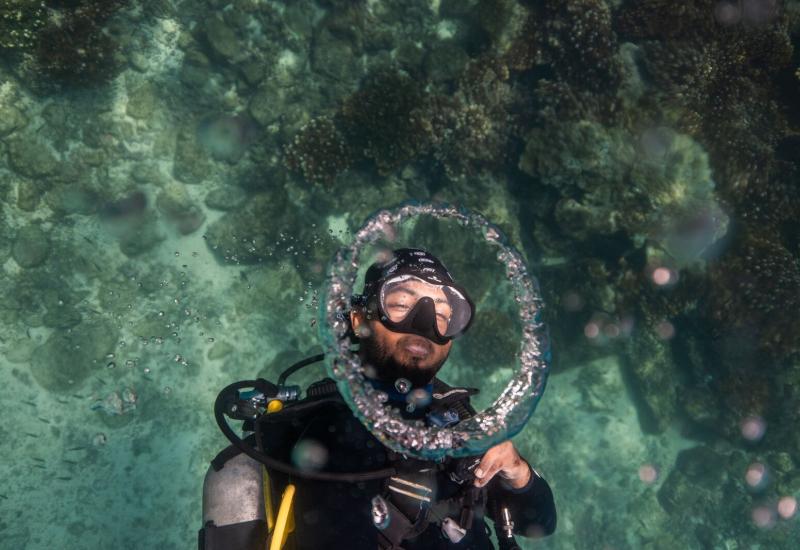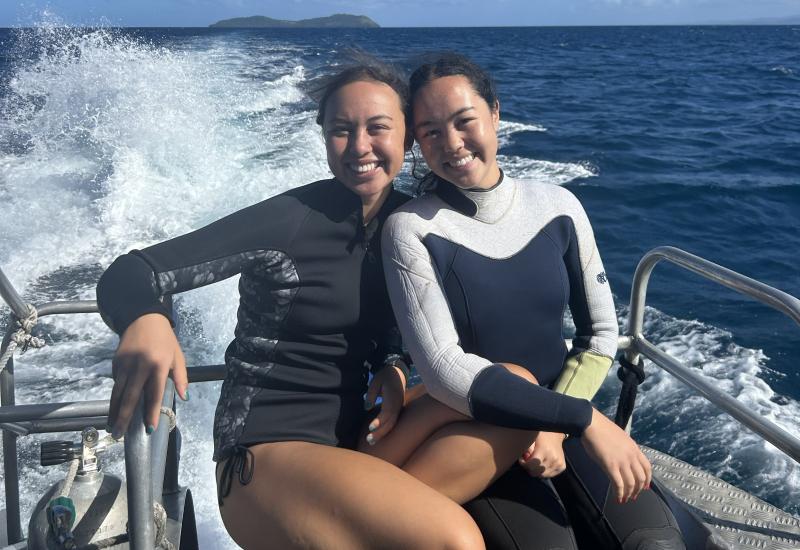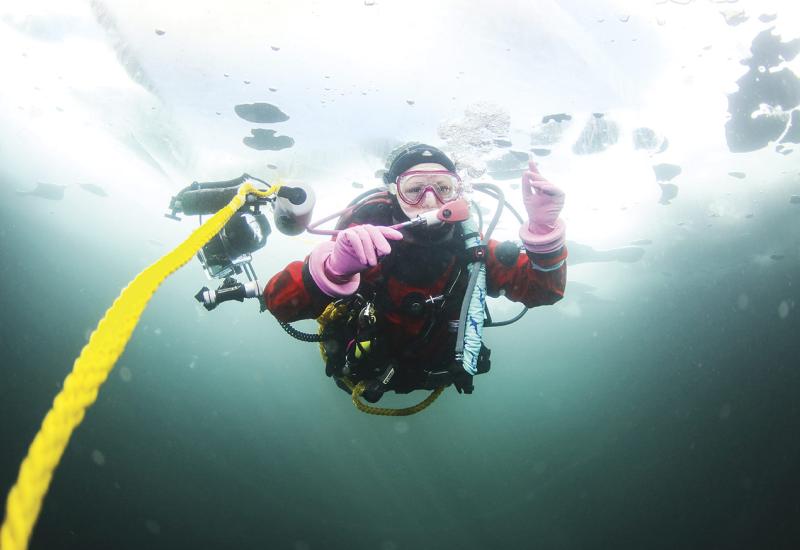Massachusetts: Cape Cod
Built from 1909 to 1914, the Cape Cod Canal, slicing through the armpit of the great peninsula, allowed Boston-bound ships instant passage into Cape Cod Bay. Previously, ships on the New York-Boston route were forced to brave the perilous waters of the sound that separated Martha's Vineyard and Nantucket from the Cape. More than 1,000 never made port, colliding with other ships in the foggy night or simply foundering, victims of errant navigation and the minefield of shoals and current-driven rips here.
While ship captains dreaded this hazardous passage, divers relish the results. New wrecks are discovered here almost every year as storms unearth long-forgotten ships. "With a little time, effort and unsophisticated equipment, you can locate a shipwreck that no one has dived before," says Don Ferris, author of the dive guide Exploring the Waters of Cape Cod. Plus, you'll find no shortage of dive buddies among the hardy band of local recreational divers, for whom wreck diving is a year-round passion.
Some of the favorite sites are:
Port Hunter
Barely a 15-minute boat ride from Falmouth or the Vineyard, Port Hunter is the largest intact wreck in Vineyard Sound. Loaded down with war supplies--from wool uniforms to railroad equipment--the 380-foot supply freighter never made its transatlantic haul to England in November of 1918. A hole in her port bow inflicted by the tug Covington sent the Hunter to the 60-foot sandy bottom of Hedge Fence Shoal within hours of the collision. The armistice ending World War I was signed before the month ended, and the ship was left intact where she lay.
While much of the spoils have long since been raised, the pipe-like deck gun, bolted down through three decks, cranes out over the stern, a reminder that German U-boats haunted Atlantic supply routes during both World Wars. A few phosphorus bombs that look like white bathroom tiles may still exist in the interior near the stern and should not be handled. Once topside and dry, they catch fire easily.
A counterclockwise sweep of the Hunter provides the optimal dive plan. Sloping from her bow at 25 feet to a depth of 80 at the stern, the Hunter is mostly intact, but in an advanced state of deterioration. Pockets of warm water pushed inland during summer by the Gulf Stream deposit Caribbean tropicals such as angelfish and groupers alongside tautog, striped bass and cunners.
Vineyard Lightship
Massachusetts Institute of Technology professor Dr. Harold Edgerton was experimenting with a protoype side-scan sonar in 1963 and located the Vineyard Lightship, a 112-foot beacon ship that guided incoming craft past the tip of the Elizabeth islands and safely into the sound. The first wreck ever located with side-scan sonar, she rests upright in 65 feet of water on the backside of the island, where she was brought down by a September 1944 hurricane.
The cherry-red lightship, one among a family of arks used by the twin islands to protect navigators from shoals, was denied her request to pull anchor and flee the storm's advance. Long a fixture on the horizon for Cuttyhunk islanders, she was gone the morning after the storm passed. Lost with all hands, her hull was apparently pierced by the spare anchor, which had been freed by surging waves.
"It's a nice, easy dive because the currents aren't real bad and you can dive it at any time," says Ferris.
Horatio Hall
Monomoy Island, the treacherous spit of sand that juts from the elbow of Chatham on the south Cape, is the grave site of ships as diverse as three-masted schooners and 500-foot freighters. All within relatively close proximity are the wrecks of the Aransas, Pendleton, Horatio Hall and Alva.
Considered the most popular wreck dive on the Cape, the Hall rests in 45 feet of water, her telltale six boilers unmistakable in the midships. The Hall was heavily salvaged and later dynamited because her rigging was exposed above the waterline, and she now lies cracked open like an egg, with her side walls peeled down. Rediscovered in 1984, the Hall still yields artifacts like portholes to the diligent explorer. Clinging anemones and starfish cloak her snarled steel remains.
The waters of Chatham and Monomoy, like those of the Bay to the north, are colder than those of the sound, and support pelagic life as well as species like cod, flounder, fluke, hake, pollack and stripers that willingly eat lobster tails from divers' hands. During summer, seals, blue sharks, halibut and, on rare days, basking sharks and torpedo rays may drift by the wreckage.
Most charters do the Hall as a drift dive, putting a buoy and line down with a group and following behind. According to Ferris, skilled divers can cover a mile on one tank. "Often this is how we locate new wrecks, drifting in likely spots."
Dive In: Cape Cod, Massachusetts
Season: While the primary dive season runs from April through October, dry suit divers can explore year-round. Locals favor uncrowded midwinter excursions when the storms break, seas calm and visibility soars.
Water Conditions: Water temperatures in Vineyard Sound top out in the low 70s during the hottest days of summer, but fall dramatically to the mid-30s during winter months. Water temps on Monomoy Island, perched right off the open sea, average in the mid-50s during the summer season.
Profile: Due to the strong currents sluicing between the Cape and the offshore islands, dives are conducted in the slack tide window. It's best to be suited up and anchored on site a good 15 to 30 minutes before the tidal sweep is stilled.
Essential Gear: Currents can pick up unexpectedly, especially on the outer Cape, and a surface swim back to the boat may prove impossible. Bring a safety sausage, air horn or other signaling device. Experienced wreck divers often use jonlines, a short stitch of rope three to six feet in length connected to the anchor line, to hold them against the current while making safety or decompression stops. A dive light is essential to truly appreciate the colors of marine growth on the outside of wrecks, not to mention a cursory peep at the interior. Finally, a dive flag is required by state law.
Dive Operators: Aqua Center, Sandwich: (508) 888-3444. Web: www.aquacenter.com. Aquarius Dive Center, Buzzards Bay: (508) 759-dive. Cape Anne Divers, Gloucester: (508) 281-8082. Web: www.capeanndivers.com. Sea Sports Divers, Hyannis: (508) 790-1217. Web: www.capecodseasports.com
Resources: Eldridge Tide and Pilot Book is an invaluable resource for dive planning. Exploring the Waters of Cape Cod, by Don Ferris, is a succinct guidebook for wrecks within recreational limits and a must if you're planning your own dive.
Lobstah-hunting
The other passion of Cape Cod divers? Lobster, which can be taken year-round on the Cape, though the prime season runs from April to November. A seasonal license for nonresidents, available at dive stores, costs $60. Size regulations vary from year to year, so be sure to ask before diving and to measure before taking. Provincetown Wall is a productive stretch of water between Race Point and Wood End off Provincetown. The bottom slopes gradually from 30 to 140 feet, and a string of old toilets and sinks placed in 1995 provide plenty of lobster habitat.
Built from 1909 to 1914, the Cape Cod Canal, slicing through the armpit of the great peninsula, allowed Boston-bound ships instant passage into Cape Cod Bay. Previously, ships on the New York-Boston route were forced to brave the perilous waters of the sound that separated Martha's Vineyard and Nantucket from the Cape. More than 1,000 never made port, colliding with other ships in the foggy night or simply foundering, victims of errant navigation and the minefield of shoals and current-driven rips here.
While ship captains dreaded this hazardous passage, divers relish the results. New wrecks are discovered here almost every year as storms unearth long-forgotten ships. "With a little time, effort and unsophisticated equipment, you can locate a shipwreck that no one has dived before," says Don Ferris, author of the dive guide Exploring the Waters of Cape Cod. Plus, you'll find no shortage of dive buddies among the hardy band of local recreational divers, for whom wreck diving is a year-round passion.
Some of the favorite sites are:
Port Hunter
Barely a 15-minute boat ride from Falmouth or the Vineyard, Port Hunter is the largest intact wreck in Vineyard Sound. Loaded down with war supplies--from wool uniforms to railroad equipment--the 380-foot supply freighter never made its transatlantic haul to England in November of 1918. A hole in her port bow inflicted by the tug Covington sent the Hunter to the 60-foot sandy bottom of Hedge Fence Shoal within hours of the collision. The armistice ending World War I was signed before the month ended, and the ship was left intact where she lay.
While much of the spoils have long since been raised, the pipe-like deck gun, bolted down through three decks, cranes out over the stern, a reminder that German U-boats haunted Atlantic supply routes during both World Wars. A few phosphorus bombs that look like white bathroom tiles may still exist in the interior near the stern and should not be handled. Once topside and dry, they catch fire easily.
A counterclockwise sweep of the Hunter provides the optimal dive plan. Sloping from her bow at 25 feet to a depth of 80 at the stern, the Hunter is mostly intact, but in an advanced state of deterioration. Pockets of warm water pushed inland during summer by the Gulf Stream deposit Caribbean tropicals such as angelfish and groupers alongside tautog, striped bass and cunners.
Vineyard Lightship
Massachusetts Institute of Technology professor Dr. Harold Edgerton was experimenting with a protoype side-scan sonar in 1963 and located the Vineyard Lightship, a 112-foot beacon ship that guided incoming craft past the tip of the Elizabeth islands and safely into the sound. The first wreck ever located with side-scan sonar, she rests upright in 65 feet of water on the backside of the island, where she was brought down by a September 1944 hurricane.
The cherry-red lightship, one among a family of arks used by the twin islands to protect navigators from shoals, was denied her request to pull anchor and flee the storm's advance. Long a fixture on the horizon for Cuttyhunk islanders, she was gone the morning after the storm passed. Lost with all hands, her hull was apparently pierced by the spare anchor, which had been freed by surging waves.
"It's a nice, easy dive because the currents aren't real bad and you can dive it at any time," says Ferris.
Horatio Hall
Monomoy Island, the treacherous spit of sand that juts from the elbow of Chatham on the south Cape, is the grave site of ships as diverse as three-masted schooners and 500-foot freighters. All within relatively close proximity are the wrecks of the Aransas, Pendleton, Horatio Hall and Alva.
Considered the most popular wreck dive on the Cape, the Hall rests in 45 feet of water, her telltale six boilers unmistakable in the midships. The Hall was heavily salvaged and later dynamited because her rigging was exposed above the waterline, and she now lies cracked open like an egg, with her side walls peeled down. Rediscovered in 1984, the Hall still yields artifacts like portholes to the diligent explorer. Clinging anemones and starfish cloak her snarled steel remains.
The waters of Chatham and Monomoy, like those of the Bay to the north, are colder than those of the sound, and support pelagic life as well as species like cod, flounder, fluke, hake, pollack and stripers that willingly eat lobster tails from divers' hands. During summer, seals, blue sharks, halibut and, on rare days, basking sharks and torpedo rays may drift by the wreckage.
Most charters do the Hall as a drift dive, putting a buoy and line down with a group and following behind. According to Ferris, skilled divers can cover a mile on one tank. "Often this is how we locate new wrecks, drifting in likely spots."
Dive In: Cape Cod, Massachusetts
Season: While the primary dive season runs from April through October, dry suit divers can explore year-round. Locals favor uncrowded midwinter excursions when the storms break, seas calm and visibility soars.
Water Conditions: Water temperatures in Vineyard Sound top out in the low 70s during the hottest days of summer, but fall dramatically to the mid-30s during winter months. Water temps on Monomoy Island, perched right off the open sea, average in the mid-50s during the summer season.
Profile: Due to the strong currents sluicing between the Cape and the offshore islands, dives are conducted in the slack tide window. It's best to be suited up and anchored on site a good 15 to 30 minutes before the tidal sweep is stilled.
Essential Gear: Currents can pick up unexpectedly, especially on the outer Cape, and a surface swim back to the boat may prove impossible. Bring a safety sausage, air horn or other signaling device. Experienced wreck divers often use jonlines, a short stitch of rope three to six feet in length connected to the anchor line, to hold them against the current while making safety or decompression stops. A dive light is essential to truly appreciate the colors of marine growth on the outside of wrecks, not to mention a cursory peep at the interior. Finally, a dive flag is required by state law.
Dive Operators: Aqua Center, Sandwich: (508) 888-3444. Web: www.aquacenter.com. Aquarius Dive Center, Buzzards Bay: (508) 759-dive. Cape Anne Divers, Gloucester: (508) 281-8082. Web: www.capeanndivers.com. Sea Sports Divers, Hyannis: (508) 790-1217. Web: www.capecodseasports.com
Resources: Eldridge Tide and Pilot Book is an invaluable resource for dive planning. Exploring the Waters of Cape Cod, by Don Ferris, is a succinct guidebook for wrecks within recreational limits and a must if you're planning your own dive.
Lobstah-hunting
The other passion of Cape Cod divers? Lobster, which can be taken year-round on the Cape, though the prime season runs from April to November. A seasonal license for nonresidents, available at dive stores, costs $60. Size regulations vary from year to year, so be sure to ask before diving and to measure before taking. Provincetown Wall is a productive stretch of water between Race Point and Wood End off Provincetown. The bottom slopes gradually from 30 to 140 feet, and a string of old toilets and sinks placed in 1995 provide plenty of lobster habitat.










